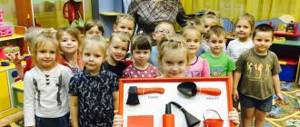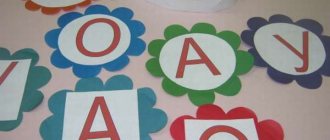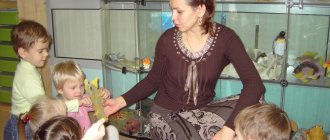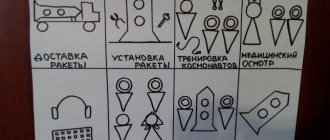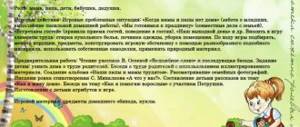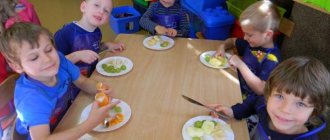Conducting role-playing games in kindergarten
The organization of role-playing games begins with the preparation of attributes and toys. For younger preschoolers, the teacher selects items for specific games and places them in the play area for free access, which stimulates interest in developing independent activities. For children 4–7 years old, attributes are stored in the play area in sections/boxes by topic (“Cookware”, “Tools”, “Medicine”). Children from older groups are happy to make materials for games with their own hands: swords from cardboard, products from plasticine, substitute drawn pictures.
Thus, pupils of the younger group are provided with a ready-made set for playing in a cafe: dishes, props, cash register, money. More information about organizing role-playing games for younger preschoolers can be found in our article - How to conduct role-playing games in the younger group of a kindergarten.
The play activity of younger preschoolers is activated using a ready-made set for role-playing games
Methodology for organizing role-playing games
The teacher gets acquainted with the long-term plan for the development and enrichment of play activities, identifies the children’s personal interests and the ability to independently think through the plot. Taking into account the data received, he begins to organize a role-playing game in the group.
- Choosing a theme for the game, drawing up a rough game plan with possible plot options.
- Preparing the gaming environment: pieces of furniture, gaming attributes and substitutes, costume details, materials for self-production of objects according to plan.
- Creating motivation and starting the game:
- the teacher creates a game or problem situation (“Guys, Cheburashka has never been to the circus, let’s show him a show?”, “The residents of Chunga-Changa island invite us to visit!”, “The dolls have accumulated a lot of dirty clothes, let’s arrange a laundry for them!” );
- conducting a short conversation on the topic of the game (“What acts are performed in the circus?”, “What is necessary for a sea voyage?”, “What household appliances are in the laundry?”);
- guide to the game (for younger preschoolers - direct, for older children - indirect): distribution of roles, designation of an approximate plot;
- Maintaining the game situation: monitoring the emotional state of all participants in the game, hints to enrich the plot, encouragement;
- Completion of the game: analysis of the roles played, implementation of the plot idea, praise for initiative and manifestation of imagination.
Video: organizing role-playing games in kindergarten at all age levels
Card index of role-playing games - table
| Age group | Methodical techniques | Approximate topics |
| First junior (nursery) | Role-playing pair interaction: the teacher, as a play partner, develops the child’s abilities and plays the “leading” role. |
|
| Second youngest | Role-playing dialogue:
|
|
| Average | The structure of the game is based on the ability to change the role of the same child during one game:
|
|
| Older | Children develop the ability to act in role-playing games according to the “Meaning Bush” principle: one child changes several roles during the game. A developmental element in the game for senior preschoolers is the introduction of a non-standard character (Baba Yaga in the hairdresser, Gena the crocodile in the museum, Cheburashka in space, etc.). |
|
| Preparatory | Role-playing games are built by children aged 6–7 years according to the principle of inventing:
|
|
Temporary game plan in kindergarten
The provisions of SaNPin on the organization of work hours in preschool educational institutions do not contain direct instructions on the duration of play activities for preschoolers. Since a role-playing game organized by a teacher is considered a form of education in kindergarten, let us equate its duration to the temporary norms of educational and physical education classes.
Table: approximate time plan of games
| Topic, group | Beginning of the game | Main part of the game | Ending the game | Total duration |
| “At an appointment at the clinic”, first junior group | The teacher invites the children to play “Polyclinic”, shows the doctor’s office, distributes roles (doctor, patients waiting in line with various complaints), talks through exemplary partner dialogues with the children. 2–3 minutes | Children in pairs act out dialogues (“What are you complaining about?”, “Doctor, I have pain...”, “Let’s do an examination,” “I’m prescribing for you...”); The role of the doctor is transferred several times to different students. 9–10 minutes | The teacher praises the children, asks about their favorite moments, and asks them to put their toys back in their places. 2–3 minutes | 15 minutes |
| "Ride the Subway", middle group | The primary distribution of roles, the guys try to think through the plot on their own, select attributes. 3–4 minutes | The teacher prompts the students to change roles, directs the plot, and suggests using additional gaming materials. 12–14 minutes | Discussion of the game as a whole, expressing impressions, planning possible options to enrich the plot 2–5 minutes | 20 minutes |
| “On the Border”, preparatory group | Distribution of roles, drawing up a game plan, preparing the place, making some attributes for the game, transformation in the dressing room. 4–7 minutes | Building a plot according to the students' ideas. 18–23 | Analysis of the game: what attributes were missing, how to improve it, diversify the plot, what to add in costumes. 3–5 minutes | 30 minutes |
If the teacher sees the children's interest in playing for a longer period of time and does not observe signs of overwork or excessive excitement, it is worth increasing the time for the game a little.
Video: role-playing game “Journey into Space” in the preparatory group (30 minutes)
Summary of the role-playing game “Beauty Salon” in the middle group - table
| Target |
|
| Equipment | Substitute items, waste material, sets of special “Children’s hairdresser” toys, towels, aprons, negligees, children’s cleaning toys, screen, tape recorder, badges. |
| Preliminary work | Excursion to a beauty salon, conversation with employees, examination of illustrative material, making attributes for the game. |
| Game Guide | — Children, today we will go to a very interesting event that will take place in our beloved city of Serpukhov. Let's put on jackets and hats (I show) and stand in pairs. Be careful and attentive on the street (the soundtrack “Street Noise” plays). - Here we are. Here on this beautiful day a new beauty salon “Cinderella” opens. And we will be its first visitors. — Tell me, children, what are beauty salons for? (children's answers) - What do people do in a beauty salon? (children's answers) Who works in the salon? (hairdresser, manicurist, cosmetologist, massage therapist, cleaner). Let's go to Cinderella. The doors are open to salon visitors! (celebratory music sounds). — Look how beautiful and cozy the salon is! This is a convenient waiting room for clients, where you can look at fashion magazines and choose a beautiful haircut. This is the hall where hairdressers work. Tell me, what kind of work do hairdressers do? What do they need to work? (children's answers) - Lisa told us better than anyone else about the work of a hairdresser. You will work as a foreman behind this chair (I show). And the second master will be Kostya. I noticed that he really likes this profession. This is your workplace behind this chair (I show). Do you remember? Let's move on. This is a manicure salon. What is the name of the master who works here? (manicurist) What is she doing? Which of you could work as a manicurist? - Okay, Katya, you will work in a manicure salon. You told me that there is also a cleaning lady working in the salon. What she does is very important. The cleaning lady keeps the salon clean and tidy. And when the salon is clean and tidy, clients like it. It's always nice to be in such a room. Hairdressers are grateful for her work. Which one of you guys could handle this role? Who can be entrusted with this responsible task? You, Arina, will be the cleaner. And with your permission, I will become the owner of the Cinderella salon. I will watch your work and help. - So, our hairdressers are Lisa and Kostya, the manicurist is Katya, the cleaning lady is Arina, and the rest are visitors. Sit down in armchairs and on the sofa, look at magazines. Do not forget to behave quietly and calmly, wait for the master to invite you. And you take everything you need for work and go to your chairs. Be attentive, polite and friendly with your clients. Handle equipment with care. Our salon is starting its work! (music sounds). Perform game actions. - Children, the working day is ending, it’s time for us to close the beauty salon. Tomorrow it will definitely open its doors for you. — What roles did you enjoy playing? — What was interesting in the game? — How many of you would like to work in a beauty salon when you become adults? |
In role-playing games, children learn to master elements of new professions, for example, nail technicians
“Substitute objects in children’s play and their inclusion in play-based educational situations”
The work of teaching children to play with substitute objects begins with giving objects unusual functional meanings. Bringing a brick to his mouth, the teacher says: “Yum-yum, pie” (tapping the ball (Kinder Surprise capsule) on the table and breaking the testicle), putting a large ring on his elbow ‒
"handbag") Each game meaning must be expressed in action and word. Having shown the action, the teacher invites the children to repeat it in a game plot: “Try my pie!” or “Is this your pie? Let me try."
Then games are organized using substitute objects, representing toys that are well known to the children, but are currently missing. First, substitutes are offered as auxiliary items (soap, candy), and then as main ones. For example, a folded fluffy scarf is a kitten being put to bed.
It is necessary to play out any random action that occurs in the child with toys and objects. You need to enter game tasks. For example, give a cube and ask the child to roll it like a car. If the baby finds it difficult, then show how you did it, accompanying your actions with speech. Gradually such tasks become more difficult.
As the game develops, the use of substitute objects becomes more conscious and independent... For example, a child puts a ring on his head ‒
this is a “hat”, hang it on your hand
–
“handbag”, etc. If a child uses a substitute in independent play, you must definitely ask him what it is, so that he verbally points out the conditional meaning of the object.
The introduction of substitute objects prepares children to engage in “imaginary actions” with imaginary objects in the game: combing with a comb that is not there, licking imaginary ice cream, treating imaginary candy, etc.
It is necessary to include the child in any activity. For example: when doing laundry, say: “Now I’ll put the laundry in the machine. Now I'll turn it on. She hummed: “ooh-ooh,” the water in her gurgled: “glug-glug,” and the laundry tumbled and groaned: “oh-oh.”
Then, after such “joint activity,” you need to play out this situation on substitute objects.
When teaching children to act with substitute objects, two ‒
three times a week the teacher creates
problem-game situations.
“The doll Olya soiled her dress”; “The fox has no house,” etc. For this, the teacher specially organizes the subject environment. For example, in the doll corner there is a doll whose dress is dirty. The teacher helps children notice the unusualness of the situation, discover the problem and solve it: wash the doll’s dress, build a house out of bricks for the fox, etc.
Attributes and visual material for games
There are many ideas on how to diversify children's games using various attributes and design options. Substitute items and toys for role-playing games can be easily made with your own hands, including from waste material. Pupils and parents should be involved in replenishing the material base of the play corner.
Video: attributes for role-playing games
Photo gallery: ready-made sets for games
Workwear and tools for playing construction games
Phonendoscope, other instruments and bubbles for playing the role of a doctor
Cash register, basket and goods for playing supermarket/shop
Menu and set of products for playing in a cafe
Set of utensils for family games, kitchen, restaurant
Tools for cutting, styling and hairstyles
The toys in ready-made sets are functional: a calculator is built into the cash register, the burners on the kitchen stove light up, the hair dryer makes noise and blows, the drill rotates, etc. These attributes for games are the most accurate copies of real appliances and tools, they are bright and comfortable.
Photo gallery: attributes made from waste material
Attributes for playing space travel
Attributes for playing grocery store or cafe
Attribute for playing construction or apartment renovation
Attributes for playing correspondents
Attribute for playing office, agency
Attributes for playing kitchen, cafe, farm
Attribute for playing clinic
Attribute for playing beauty salon/nail salon
Using homemade objects in games arouses genuine interest in children and stimulates their imagination. Children often create simple substitute objects for games themselves: sticks as sabers, elements from construction sets as tools for construction, etc. Waste material is used to enrich the play environment: bubbles and jars for playing in the pharmacy and treatment room, empty bottles and boxes with labels - for filling the shelves of a grocery store, bottles of shampoos, nail polishes - for a beauty salon.
Photo gallery: role-playing costumes
Ready-made costumes for role-playing games can be placed in the dressing room or play area
A simple version of role-playing costumes with your own hands: decorate aprons with special designations of professions
Attributes and elements of costumes for playing sea voyage
DIY astronaut costume
Hats for the game based on a folk tale
Children love to transform and try on elements of workwear: caps, construction helmets, aprons, hats. Role-playing costumes for children's games are easy to make yourself: add symbolic designations of professions to aprons, make hats or masks of heroes for story-based games.
An incident from the life of the author of the article: children came up with a game about superheroes. There were no special masks or clothes at home, and my imagination immediately kicked in! The superhero mask was made from a piece of dark fabric with slits for the eyes. The Wonder Girl costume was made from her mother’s T-shirt and a hat made from a plastic sheet.
Children are incredible dreamers; they make costumes out of simple things and can imagine themselves as anyone
Photo gallery: design of the gaming environment
The pharmacy display window with a window was made by hand using printed images of medicines (leaflets can be taken at any pharmacy)
Filling with real objects (fabric samples, sewing supplies, pattern magazines) encourages children to become more familiar with the structure of the atelier
Original design of the gaming environment using waste material
An ATM for a modern game can be made from an ordinary box
The most important thing in a gaming environment with a nautical theme is the presence of a ship
The gaming environment consists of homemade items with the symbols of Russian Post
Equipment items were used for a modern role-playing game, and children's drawings were used to decorate the gaming office.
The gaming environment is filled with real objects (tools and devices) and an important homemade attribute - a table for assessing vision
As mentioned above, gaming activities are rapidly developing with the use of real objects and waste material. Children try to bring their games as close to reality as possible. Therefore, in the design of the gaming environment, it is advisable to use non-working household and technical appliances, magazines and books, empty containers with labels, and signs with logos of existing companies.
Story games for children 2-3 years old and their goals.
When taking part in games with their baby, parents should understand that in this way they contribute to the achievement of some important goals:
- Nurturing a child's personality traits.
The basic concepts of what is good and what is bad, what is good and what is evil, are laid down during the game. At the same time, he understands without much emphasis that it is better to be polite than rude, modest than impudent, generous than greedy. - Socialization gradually manifests itself in games.
The baby learns to communicate with parents and other children, to be friends with them. He can learn to defend his own opinion. - Success in play lays the foundation for a child’s self-esteem.
He gains confidence in his abilities - the most important quality necessary in life. - If the game is active, it contributes to the physical development of the child.
He learns to walk and run, work with various objects, becomes stronger and more resilient. - Fine motor skills, precise movements used in play, are extremely important
for the harmonious development of a child, since they are directly related to the development of correct speech. - Finally, story-based games for children 2-3 years old develop the child’s attention, memory, imaginative thinking and imagination
, and train his psyche.
Story-based role-playing games for children 3-4.
Analysis of role-playing games
In order to identify the effectiveness of the teacher’s organizational abilities in role-playing games and adjust the plan for further activities, the teacher analyzes the game.
The protocol is drawn up according to the following criteria:
- Correspondence of the theme and content of the game to the interests of the students and the level of their gaming skills.
- Correspondence of the preparatory stage to the age category of children.
The playing environment, the choice of attributes and the plot plan are thought out by the teacher - for younger children. Children independently selected attributes from those proposed and outlined a game plan - middle age. In accordance with the theme of the game, the pupils themselves prepared the subject conditions, made the material and attributes, assigned roles and developed the plot - older preschoolers.
- Description of methods for guiding the course of gaming activities, their effectiveness.
- What tasks were implemented in the game.
- Assessment of pupils’ activities:
- means of embodying roles (use of costumes, facial expressions, gestures, expressiveness of speech);
- use of attributes;
- communicative aspect in the game (interaction with a partner, help, absence of conflict situations).
- Completion of the game: the logical conclusion of the game plot, the emotional state of the children (signs of overwork, high spirits, desire to develop the game plot in the future).
- The direction of the teacher’s subsequent work: adjusting/improving the methodology for conducting the game, what means to enrich the children’s gaming experience.
Proper organization of play activities in kindergarten contributes to the development of personal qualities of pupils. In role-playing games, children expand their understanding of relationships between adults, form primary professional competencies, and gain respect for human work. Children show initiative in developing stories on everyday and fantastic themes, revealing their creative potential by transforming into the assigned role.
Methodological recommendations “Methods and techniques for managing role-playing games for children”
Natalia Derevyankina
Methodological recommendations “Methods and techniques for managing role-playing games for children”
When leading role-playing games, educators are faced with the following tasks:
• development of games as an activity (expanding the themes of games, deepening their content);
• using the game to educate children's groups and individual children,
Directing a role-playing game requires great skill and pedagogical tact. The teacher must direct the game without disturbing it, and maintain the independent and creative nature of the game activity.
Indirect techniques - without direct intervention in the game (bringing in toys, creating a play environment before the start of the game).
Direct techniques - direct involvement of the teacher in the game (role-playing participation in the game, participation in the collusion of children, explanation, help, advice during the game, suggesting a new topic for the game, etc.). The teacher influences both the choice of topic and the development of its plot, helps children distribute roles, filling them with moral content.
The following pedagogical approach is presented in the studies of S. L. Novoselova and E. V. Zvorygina, who developed a comprehensive method for managing the game. The integrated method of guidance is a system of pedagogical influences that promote the development of children’s independent story-based play, based on its age characteristics and the potential development of the child’s intelligence.
This method includes the following components: - systematic, pedagogically active enrichment of children’s life experience;
- joint (educational) games between the teacher and children, aimed at conveying to them the gaming experience of the traditional culture of play; — timely changes in the subject-game environment, taking into account the enriching life and gaming experience;
- activating communication between an adult and children, aimed at encouraging them to independently use new ways of solving game problems and new knowledge about the world in the game.
Early age.
Direct leadership techniques. - emotional communication between an adult and a child in joint play
- demonstration of methods of action with objects, accompanied by the speech of an adult
- joint play activities with the teacher
- inclusion of the teacher in the child’s play (to solve certain game problems)
- demonstration, training in the use of substitute objects, drawn markers of the playing space, imaginary objects in the game
- use of activating dialogue between the teacher and the child
- prompt questions
Techniques of indirect leadership.
- selection of toys with certain properties
- examination of household items and objects in the immediate environment, conversation about their purpose
- observation of the actions of adults using household items and objects of the immediate environment
— various small errands for the child (bring a chair, hang a towel on the hook)
- involving the child in all possible participation in labor activities (cleaning up toys, things)
- examination of subject pictures, small stories and illustrations
- creating a ready-made play environment (suggesting a situation - a doll and a cup are placed next to each other)
- changing a familiar game situation (replacing toys, adding new ones)
- the teacher poses a problem situation
Conclusion: In everyday life, a child gains practical experience in operating objects and transfers this experience into independent play. Play at an early age is of an introductory nature and is an object-based play activity . By the end of early childhood, the game acquires the status of a display game in which operations with objects become actions aimed at achieving a certain effect with the help of a given object.
Junior preschool age.
Direct leadership techniques.
Second junior group
Teaching ways to reflect reality in games:
- inclusion of the teacher in the game (in order to convey gaming experience)
- teaching game actions and role-playing dialogue by example
Activating communication between the teacher and children during the game:
- questions (Who are you? Or are you a driver? I’m late for work, please give me a lift)
- encouragement
-encourages statements (Ask your daughter, she’s not hungry)
- teacher’s help to unite in the game (You’re probably bored alone, invite Olya, she’s also walking with her daughter)
Middle group
- inclusion of the teacher in the game, taking on the main or secondary roles (not often)
— the teacher’s entry into a role-playing conversation (in order to activate the role-playing dialogue)
Techniques of indirect leadership.
Enriching the real experience of children in active activities:
- introducing vivid images and impressions into classes to familiarize yourself with the environment
- excursions, observations, meetings with people of certain professions, accompanied by conversations with children
- creating situations that encourage the child to enter into relationships with others (assignments)
- reading works of fiction, dramatizing fairy tales
- watching other children play
-reminders about interesting facts from life.
Organization of the subject-game environment
- a combination of toys, substitute items, role attributes, imaginary toys
- introducing a new toy into the environment
- children making attributes for the game
Enriching children's social experience in everyday life:
- getting to know the environment through active activities (observations, excursions, conversations, using TSO, reading literature, looking at illustrations and paintings)
- creation by the teacher of special situations in order to establish contacts between the child and others.
Organization of educational games by the teacher:
- theatrical games
- games like “Guess who came?” "Guess who I'm impersonating?"
— didactic games “Who needs what for work”...
Creating a game problem situation: - with the help of play equipment (attributes, decorations, items of clothing, toys) - with the help of activating communication between the teacher and children.
- encouragement
- attracting inactive children to the game.
Conclusion: Based on in-depth knowledge about the world around them, children creatively implement interesting ideas in play. The game is undergoing changes from a figurative role-playing game to a plot-role-playing game. By the age of 5, children have mastered well the methods of object-based play actions, play freely with toys, with substitute objects, with imaginary objects, easily give verbal designations, and are able to convey the characteristic features of a role using means of expressiveness. Children are able to engage in role-playing interactions for a longer period of time.
Senior preschool age.
Direct leadership techniques.
- Inclusion of the teacher in the game, taking on a role (main or secondary) - not often, as necessary (showing a speech sample, collective discussion of the role behavior of the players after the game).
Techniques of indirect leadership.
– enriching children’s social experience through all types of activities (observations, excursions, reading fiction, watching children’s TV shows, conversations)
— involving children in the production of attributes and design of playing fields.
Creating conditions for the development of creative role-playing games:
- creation of an object-based play environment (thematic play corners typical for younger and middle ages - “Hospital”, “Barbershop”, where play equipment and toys are located in a characteristic way, not typical for older age)
- arrangement of various gaming materials in butts (boxes, containers, drawers with conventional and realistic toys and attributes,
- inclusion of “semi-finished toys” into the environment for making homemade products,
— replenishment and enrichment of the gaming environment in accordance with the knowledge acquired in the classroom.
Adult help:
- remember events that are more suitable for the game, establish their sequence
- plan the course of the game, sequence of actions
- distribute roles, agree on plans,
— assistance in solving game problems, maintaining cognitive interest in the game,
- watching children play,
- direction of children’s plans and actions (advice, hint, question, changing the play environment)
- creation of problematic situations (flexible influence on the concept of the game, plot development, complication of ways of displaying reality,
- create a game situation,
- individual work (the child does not know how to play; you can use the experience of children who play well.
Conclusion: by the age of five, children are able to independently organize a role-playing game - choose a topic, create conditions, perform appropriate game actions and rules of behavior. The teacher uses mainly indirect methods of guiding the game.
